Have you ever found yourself wishing for more hours in a day? Does it feel like time slips through your fingers, leaving you with a never-ending to-do list and a mounting sense of overwhelm? In today's fast-paced world, effective time management has become a crucial skill to navigate the demands of work, personal life, and self-care.
By honing your time management skills, you can not only accomplish more in less time but also free up mental space and reduce stress. This article will delve into the top strategies for optimizing your use of time, equipping you with invaluable tools to enhance your productivity and achieve your goals.
One essential aspect of time management is prioritization. Identifying your most important tasks and dedicating the necessary time and energy to them is key to avoiding the trap of busyness without productivity. By distinguishing between urgent and important tasks, you can ensure that your time is allocated sensibly and that you are focusing on what truly matters.
Another vital element of effective time management is the art of delegation. Although it may be tempting to carry the weight of all responsibilities on your shoulders, delegating tasks to others not only lightens your workload but also provides an opportunity for growth and empowerment. Trusting others with certain responsibilities allows you to focus on higher-value tasks, enabling you to make a more significant impact.
Prioritize Tasks and Create a To-Do List
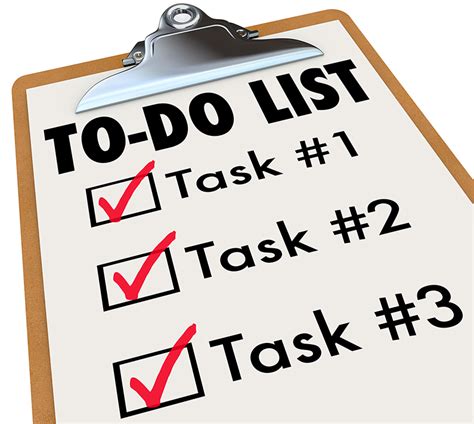
One essential aspect of effective time management is the ability to prioritize tasks and create a to-do list. By organizing and categorizing your tasks based on their importance and urgency, you can efficiently allocate your time and ensure that you focus on the most crucial tasks first.
Begin by evaluating the significance of each task and determining which ones are prioritized over others. Consider the potential impact and consequences of completing or neglecting each task. This evaluation process will enable you to establish a clear hierarchy of tasks.
Next, create a comprehensive to-do list that outlines all the tasks you need to accomplish. Writing down your tasks helps you visualize and remember them, increasing your chances of completing them. Make sure to include all necessary details such as deadlines, dependencies, and any additional information that will assist with task completion.
Once you have your to-do list, it's helpful to group similar or related tasks together. This grouping allows you to streamline your work and minimize context switching, ultimately enhancing your focus and productivity.
Consider using a priority matrix or a task management tool that allows you to assign deadlines and monitor the progress of each task. This way, you can easily identify tasks that require immediate attention and adjust your schedule accordingly.
Regularly review and update your to-do list as new tasks arise or priorities shift. By keeping your to-do list current, you ensure that you have a clear overview of your responsibilities and can make informed decisions about what to tackle next.
Remember that effective prioritization is not just about completing tasks but also about making conscious decisions about which tasks are worth your time and effort. It's okay to delegate or eliminate tasks that are low-value or not aligned with your goals or priorities.
| Benefits of Prioritizing Tasks and Creating a To-Do List: |
|---|
| 1. Enhanced focus and productivity |
| 2. Efficient allocation of time |
| 3. Clear overview of responsibilities |
| 4. Effective decision-making |
| 5. Reduced stress and overwhelm |
Set Clear Goals and Objectives
In order to enhance productivity and optimize time management, it is essential to establish clear, well-defined goals and objectives. By determining specific outcomes and milestones, individuals can effectively prioritize tasks and allocate their time more efficiently.
By setting clear goals and objectives, individuals can gain a sense of direction and purpose, allowing them to focus their energy on tasks that align with their priorities. This clarity helps to eliminate distractions and ensures that time is spent on activities that contribute to overall progress and success.
- Define Measurable Targets: By establishing achievable and measurable targets, individuals can track their progress and evaluate their efficiency. Clear objectives allow for better monitoring and adjustment of tasks, resulting in improved time management.
- Break Down Goals into Smaller Tasks: Breaking down larger goals into smaller, manageable tasks makes them less overwhelming and easier to tackle. This approach enables individuals to allocate their time effectively and complete tasks in a more organized and efficient manner.
- Set Realistic Deadlines: It is important to set realistic deadlines for each task or objective. Unrealistic time frames can lead to stress, poor quality work, and difficulties in achieving desired outcomes. By setting achievable deadlines, individuals can maintain motivation and ensure effective time utilization.
- Prioritize Based on Importance and Urgency: Prioritizing tasks based on their importance and urgency allows individuals to allocate their time and efforts accordingly. This strategy ensures that crucial tasks are completed first, minimizing the risk of missed deadlines or incomplete work.
- Regularly Review and Adjust Goals: Time management is an ongoing process, and it is essential to regularly review and adjust goals as necessary. By reevaluating objectives and modifying them when needed, individuals can stay aligned with their changing priorities and work towards their desired outcomes.
Setting clear goals and objectives provides a roadmap for effective time management. It allows individuals to stay focused, make informed decisions about task prioritization, and achieve desired results more efficiently. By utilizing this strategy, individuals can maximize their productivity and optimize their use of time.
Break Down Larger Tasks into Smaller, Manageable Steps
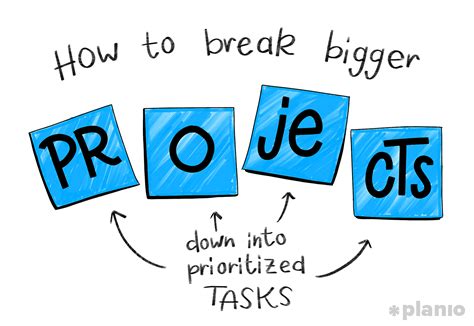
Efficient time management involves tackling larger tasks by breaking them down into smaller, more manageable steps. This approach allows for a structured and organized workflow, enabling smoother progress and improved productivity.
| Benefits of Breaking Down Tasks |
|---|
1. Enhanced Focus: By dividing larger tasks into smaller steps, you can concentrate on one aspect at a time. This eliminates distractions and improves your ability to stay focused on the task at hand. |
2. Increased Motivation: Breaking down tasks helps to build a sense of accomplishment as you complete each step. This boosts motivation and provides a greater sense of progress, encouraging you to continue working efficiently. |
3. Improved Planning: Breaking tasks into smaller steps aids in developing a well-defined plan. It allows you to assess the resources and time required for each step, enabling more accurate scheduling and allocation of resources. |
4. Reduced Overwhelm: Large tasks can be overwhelming, causing stress and decreasing productivity. Breaking them down into manageable steps eliminates the feeling of being overwhelmed, making the process more manageable and less daunting. |
5. Enhanced Problem-solving: When tasks are split into smaller steps, it becomes easier to identify any potential challenges or obstacles. This enables you to proactively address these issues, resulting in more efficient problem-solving and reduced time wasted. |
Enhancing Productivity by Eliminating Distractions and Cultivating Focus
In today's fast-paced world, where distractions are abundant and productivity is paramount, it's essential to implement effective strategies to eliminate distractions and maintain focus. By adopting techniques that help you stay on track and prioritize essential tasks, you can significantly enhance your time management skills and maximize productivity.
- Avoid multitasking: Instead of splitting your attention between multiple tasks, focus on one task at a time. This allows you to give your undivided attention and complete tasks efficiently.
- Create a dedicated workspace: Establishing a designated area for work can significantly reduce distractions and help you maintain focus. Arrange your workspace in a way that minimizes interruptions and creates a conducive environment for productivity.
- Turn off notifications: Constant notifications from emails, social media, and messaging apps can derail your concentration. Disable non-essential notifications during work hours to prevent interruptions and maintain your focus on important tasks.
- Implement time-blocking techniques: Dividing your day into specific time blocks for different tasks allows you to allocate time efficiently and stay focused on individual responsibilities. Set realistic goals for each time block to optimize productivity.
- Establish clear priorities: Clearly define your goals and prioritize tasks based on their importance and urgency. This helps in avoiding unnecessary distractions and ensures that you allocate your time and energy towards what truly matters.
- Practice mindful breaks: Taking short breaks at regular intervals can help refresh your mind and improve focus. Engage in activities such as stretching, deep breathing, or a quick walk to recharge yourself and enhance your productivity levels.
- Minimize digital distractions: Remove unnecessary apps or bookmarks from your devices that often lead to mindless browsing. Decluttering your digital space can help you stay focused and avoid falling into the trap of endless scrolling.
- Utilize productivity tools: Explore the wide range of productivity tools available, such as task management apps, time trackers, and focus apps. These tools can assist you in organizing your tasks, tracking progress, and staying on track throughout the day.
- Practice the Pomodoro Technique: This time management method involves working in focused bursts of 25 minutes, followed by a short break. By breaking your work into manageable intervals, you can maintain concentration and improve efficiency.
- Set boundaries and communicate them: Clearly communicate your availability and boundaries to colleagues, clients, or family members to avoid unnecessary interruptions. Establishing boundaries helps you create uninterrupted time for focused work.
By incorporating these techniques into your daily routine, you can eliminate distractions, develop a strong sense of focus, and optimize your time management skills. Remember, enhancing productivity is a continuous process, and discipline and consistency are key to achieving lasting results.
Delegate Tasks and Learn to Say No
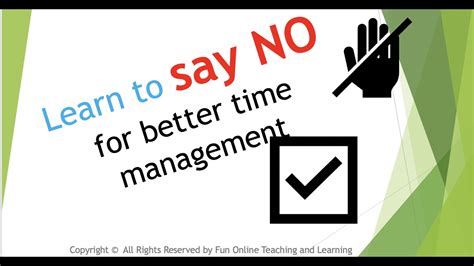
In this section, we will explore two essential skills for effective time management: delegating tasks and learning to say no. Delegation involves entrusting specific responsibilities to others, allowing you to focus on higher-priority tasks and utilize the skills and expertise of your team members. It is an essential tool for maximizing productivity and efficiency.
Learning to say no is equally important as it enables you to prioritize your time and energy for tasks that align with your goals and values. Saying no to nonessential or low-priority tasks helps you maintain focus and avoid overcommitting yourself, ensuring that your valuable time is invested in activities that bring the most significant impact.
| 1. Delegation: | 2. Saying No: |
| Delegate tasks to competent team members who possess the necessary skills and knowledge. Utilize their expertise to streamline workflow and increase overall productivity. | Learn to assess requests and determine whether they align with your goals and priorities. Politely decline nonessential tasks that do not contribute to your productivity or overall success. |
| Delegate responsibilities based on individuals' strengths and interests, empowering them to take ownership and contribute to the team's success. | Communicate your boundaries effectively and assertively, ensuring that you allocate your time and energy to tasks that are aligned with your objectives and commitments. |
| Regularly communicate with your team, providing guidance, support, and feedback to enable them to execute delegated tasks effectively. | Avoid overcommitting yourself by setting clear priorities and staying true to them. Evaluate the impact and importance of each request before accepting or declining. |
| Monitor progress and provide constructive criticism when necessary. Trusting your team and effectively delegating tasks allows you to focus on higher-level responsibilities. | Remember that saying no is not a sign of weakness but a strategic decision to protect your time and energy. Prioritize tasks that align with your long-term goals. |
By mastering the art of delegation and learning to say no, you can enhance your time management skills, increase productivity, and achieve better work-life balance. These two strategies empower you to make conscious choices about how you allocate your time and ensure that you invest it in tasks that bring the most significant impact and align with your personal and professional aspirations.
Utilize Technology and Tools to Streamline Processes
In today's fast-paced world, leveraging technology and utilizing various tools can significantly enhance time management and efficiency. Incorporating these resources into your daily routines can streamline processes, optimize productivity, and enable you to accomplish more in less time.
| 1. Automation: | Implement automation tools to minimize repetitive tasks and save time. This can include setting up automated email responses, utilizing task management software, or using chatbots to handle customer inquiries. |
| 2. Calendar Apps: | Take advantage of calendar applications to organize your schedule, set reminders, and efficiently manage your time. Sync your calendar across devices to stay updated and avoid scheduling conflicts. |
| 3. Project Management Software: | Employ project management tools to plan, track, and collaborate on tasks and projects effectively. These tools provide visibility, facilitate communication, and enable teams to work together seamlessly. |
| 4. Time Tracking Apps: | Utilize time tracking applications to monitor how you spend your time. By tracking your activities, you can identify areas of improvement, eliminate time-wasting activities, and focus on essential tasks. |
| 5. Cloud Storage: | Embrace cloud storage solutions to store and access your files from anywhere, eliminating the need for physical storage devices. This enables easy collaboration, version control, and ensures data security. |
| 6. Communication Tools: | Opt for efficient communication tools such as instant messaging apps, video conferencing, and collaborative platforms. These tools facilitate quick and effective communication, reducing the need for lengthy face-to-face meetings. |
| 7. Task Prioritization Apps: | Use task prioritization applications to prioritize your to-do lists based on importance and urgency. These apps help in managing deadlines, allocating time to specific tasks, and ensuring a structured workflow. |
| 8. Mobile Productivity Apps: | Take advantage of productivity applications on your mobile devices to optimize time usage while on the go. These apps offer features like note-taking, reminders, and task management, keeping you organized and efficient. |
| 9. Keyboard Shortcuts: | Familiarize yourself with keyboard shortcuts for commonly used software and applications. Mastering keyboard shortcuts can save considerable time by eliminating the need to navigate through menus and options manually. |
| 10. Time Management Apps: | Explore specialized time management apps that assist in tracking and analyzing your time usage. These apps provide insights into your productivity patterns, allowing you to make informed decisions to optimize your time. |
By incorporating technology and utilizing various tools, you can streamline processes, improve productivity, and ultimately make the most of your available time. Experiment with different resources to find the ones that work best for your unique needs and maximize your time efficiency.
Take Regular Breaks and Practice Time Blocking
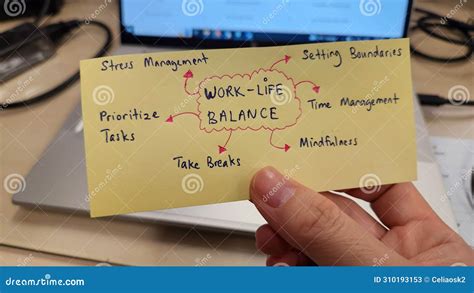
Developing effective time management skills involves more than just creating a schedule and sticking to it. It also requires incorporating breaks into your routine and implementing a technique called time blocking. Taking regular breaks and practicing time blocking can significantly boost your productivity and enhance your overall efficiency.
1. Incorporate breaks into your work routine: Intentionally stepping away from your tasks at regular intervals can refresh your mind, increase focus, and prevent burnout. Whether it's a short walk, stretching, or a quick breathing exercise, taking breaks allows you to recharge and return to your work with renewed energy.
2. Embrace the power of time blocking: Time blocking is a time management technique where you schedule specific blocks of time for different activities or tasks. By allocating dedicated time slots for each task or project, you can concentrate solely on the task at hand without distractions. This method helps you set clear boundaries and ensures that important tasks receive the attention they deserve.
3. Prioritize and allocate time accordingly: Analyze your tasks and determine their importance and urgency. Assign time slots for high-priority tasks during periods when you are most productive and focused. Distribute your workload evenly throughout the day, allowing for breaks and rest periods to maintain a sustainable pace. Efficiently managing your time by prioritizing and allocating it wisely can prevent procrastination and ensure that critical tasks are completed on time.
4. Use visual aids: Visual aids such as calendars, planners, or digital tools can support your time blocking efforts. They provide a visual representation of your schedule, making it easier to understand and follow. Utilize color-coding or symbols to identify different tasks and specific time blocks, enabling you to quickly recognize your planned activities at a glance.
5. Avoid multitasking: While multitasking may seem like a way to get more done in less time, it often leads to decreased productivity and increased errors. Focus on one task at a time during each time block to maximize your efficiency and ensure quality results. By eliminating distractions and honing in on a single task, you can achieve greater concentration and effectiveness.
6. Experiment and adjust: Time management is a personal journey, and what works for one person may not work for another. Experiment with different time blocking techniques, durations for breaks, and intervals between tasks to find a routine that suits your workflow and enhances your productivity. Continuously evaluate and adjust your approach based on your own experiences and feedback.
7. Maintain a healthy work-life balance: Taking regular breaks not only improves your work performance but also contributes to a balanced and fulfilling life. Use your breaks to engage in activities outside of work, such as spending time with loved ones, pursuing hobbies, or practicing self-care. Striking a balance between work and personal life is essential for overall well-being and sustained productivity.
By incorporating regular breaks into your routine and practicing time blocking, you can optimize your time management efforts and achieve greater productivity and efficiency in both your professional and personal life. Embrace these strategies and reap the benefits of effective time management.
Optimize Productivity through Effective Time Chunking
Enhancing productivity can be achieved through the implementation of a powerful time management technique known as time chunking. By breaking your workday into specific time intervals, you can maximize your efficiency and focus on crucial tasks without feeling overwhelmed or scattered.
Here are some effective strategies for incorporating time chunking into your daily routine:
- Chunk your tasks by priority: Divide your tasks into different chunks based on their level of importance and urgency. This approach allows you to prioritize and allocate your time accordingly.
- Create dedicated time slots: Designate specific time frames for particular activities or projects. By establishing focused periods, you can work on essential tasks without distractions or interruptions.
- Alternate between work and breaks: Break your day into chunks consisting of work intervals followed by short breaks. This rhythm helps maintain energy and attention while preventing burnout.
- Utilize tools and technology: Explore time management apps, calendars, or timers to assist in organizing your chunks effectively. These tools can help you track your progress and ensure that each chunk is optimized.
- Group similar tasks together: Cluster similar tasks that require similar resources or skills. This consolidation enables you to streamline processes and minimize context switching.
- Experiment with chunk durations: Test different chunk durations to find what works best for you. Some people thrive with shorter, more frequent chunks, while others prefer longer, uninterrupted sessions.
- Set realistic expectations: Be mindful of your capabilities and avoid overloading your chunks with more tasks than you can realistically accomplish. Set achievable goals and adjust as needed.
- Eliminate distractions: Prioritize creating a distraction-free environment during your chunked time. Minimize interruptions such as phone notifications or excessive background noise to enhance focus and productivity.
- Review and adjust: Regularly assess your time chunking method and make necessary adjustments. Fine-tuning your approach based on your experiences will help optimize your productivity and maximize results.
- Maintain flexibility: While time chunking helps structure your day, remain flexible to adapt to unexpected events or changes in priorities. Being adaptable allows you to balance efficiency with agility.
By implementing these strategies, you can harness the power of time chunking to optimize your productivity, accomplish tasks with focus, and better manage your time with effective time management techniques.
Developing Effective Strategies for Overcoming Procrastination
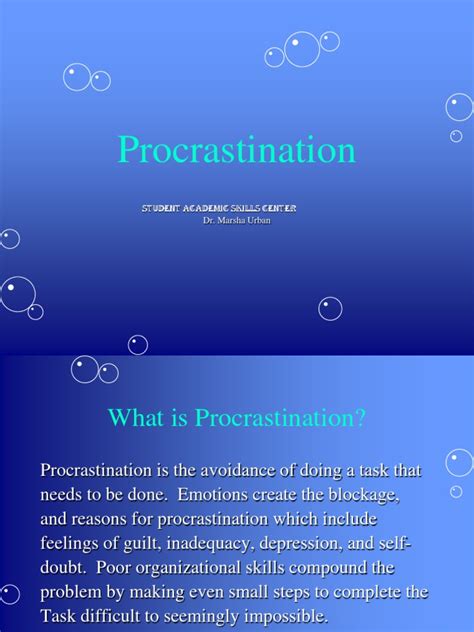
Introduction: In this section, we will explore practical and actionable techniques to conquer procrastination and enhance productivity. Time is a valuable resource, and by implementing these strategies, individuals can overcome the habit of putting off tasks and achieve greater efficiency in their daily lives.
1. Cultivate self-awareness: Start by understanding the underlying reasons behind your procrastination. Recognizing patterns and triggers can help you identify and address the root causes, allowing you to develop tailored strategies for overcoming this habit.
2. Break tasks into smaller steps: Often, procrastination arises from feeling overwhelmed by the magnitude of a task. By breaking it down into smaller, more manageable steps, you can reduce anxiety and make progress towards completion.
3. Prioritize and set clear goals: Establishing clear priorities and setting achievable goals can provide a sense of direction and motivation. By focusing on the most important tasks first, you can minimize the urge to procrastinate on less critical activities.
4. Utilize time-blocking techniques: Allocate specific blocks of time for different tasks or activities. By creating a structured schedule, you can increase accountability and reduce the temptation to procrastinate.
5. Practice the "two-minute rule": If a task can be completed in less than two minutes, do it immediately. By taking immediate action on small tasks, you can prevent them from accumulating and becoming a source of procrastination.
6. Utilize positive reinforcement techniques: Acknowledge and reward yourself for completing tasks or making progress. Positive reinforcement can be a powerful motivator and help combat procrastination.
7. Identify and eliminate distractions: Identify the distractions that commonly derail your focus. Whether it's social media, emails, or noisy environments, take steps to minimize or eliminate these distractions during important tasks.
8. Develop a procrastination contingency plan: Anticipate potential obstacles and develop strategies to overcome them. Having a plan in place for dealing with unexpected situations or moments of procrastination can help you stay on track.
9. Seek accountability: Share your goals and deadlines with others who can help hold you accountable. This could be a friend, colleague, or mentor who can provide support, encouragement, and gentle reminders to stay motivated.
10. Embrace a growth mindset: Instead of viewing procrastination as a personal failing, adopt a growth mindset. Recognize that setbacks and delays are part of the learning and improvement process, and use them as opportunities for growth.
By implementing these effective strategies for handling procrastination, individuals can regain control over their time and enhance their overall productivity and efficiency.
Evaluate and Adjust Your Strategies for Efficiently Managing Your Time
Regularly assessing and adapting your approach to time management is essential for improving productivity and accomplishing your goals. Effective time management involves analyzing your current strategies, identifying areas for improvement, and making necessary adjustments to optimize your use of time.
Evaluate your current practices: Take the time to reflect on your existing time management tactics and their effectiveness. Are there any habits or techniques that are consistently causing delays or hindering your progress? Be honest with yourself and identify any areas that need improvement.
Identify your priorities: Determine your most important tasks and goals, considering both short-term and long-term objectives. Clearly defining your priorities will help you allocate your time and energy more efficiently.
Create a schedule: Develop a daily, weekly, or monthly schedule that outlines your planned activities and goals. Organize your tasks in a logical order and allocate specific time slots for each task. A well-structured schedule will provide a clear roadmap for your day and help you stay on track.
Eliminate time-wasting activities: Identify any activities or habits that consistently waste your time without contributing to your goals. This may include excessive social media use, unnecessary multitasking, or engaging in unproductive conversations. Minimize or eliminate these distractions to maximize your productivity.
Set realistic deadlines: Avoid overcommitting yourself and setting unrealistic deadlines for tasks. Instead, set realistic and achievable deadlines that allow for proper planning and execution. This will help you avoid stress and ensure that you have enough time to complete each task effectively.
Seek feedback: Reach out to colleagues, mentors, or trusted friends who are skilled in time management and ask for their input. Their perspectives and insights can provide valuable feedback and help you refine your time management strategies.
Stay adaptable: Recognize that circumstances and priorities can change, requiring adjustments to your plans and strategies. Remain flexible and open-minded, ready to adapt to new challenges and opportunities that may arise.
Practice self-discipline: Cultivate self-discipline to stay focused on your tasks and resist the temptation to deviate from your schedule. Develop strategies to manage distractions and stay committed to your goals.
Regularly review and adjust: Schedule regular time to evaluate your progress and revise your time management strategies as needed. Reflect on your accomplishments, challenges, and areas for improvement. By consistently reviewing and adjusting your approach, you can continually enhance your time efficiency.
Remember, effective time management is a skill that can be developed and refined. By regularly evaluating and adjusting your strategies, you can make significant strides in maximizing your productivity and achieving your objectives.
FAQ
What are some tips for maximizing time efficiency?
Some tips for maximizing time efficiency include prioritizing tasks, setting clear goals, minimizing distractions, using time management tools, and delegating tasks when possible.
How can I prioritize my tasks effectively?
You can prioritize your tasks effectively by making a to-do list, identifying urgent and important tasks, using the 80/20 rule (also known as the Pareto Principle), and breaking larger tasks into smaller, manageable steps.
What are some common distractions and how can I minimize them?
Some common distractions include social media, excessive noise, and multitasking. To minimize distractions, you can turn off notifications, designate specific times for checking social media, find a quiet work environment, and focus on one task at a time.
How can time management tools help in improving efficiency?
Time management tools such as calendars, to-do lists, and productivity apps can help in improving efficiency by providing a visual representation of your tasks, setting reminders, tracking progress, and helping you prioritize and organize your time effectively.
When should I consider delegating tasks?
You should consider delegating tasks when they can be done equally well by someone else, when you have too many tasks to handle alone, or when the task falls outside your area of expertise. Delegation allows you to focus on higher-priority tasks and helps in increasing overall productivity.
How can I improve my time efficiency?
There are several strategies you can implement to improve your time efficiency. First, make a to-do list and prioritize tasks based on their importance and urgency. Additionally, try to eliminate distractions and develop time-blocking techniques to stay focused on specific tasks. Furthermore, delegate tasks when possible and learn to say no to non-essential commitments. Finally, make sure to take breaks and practice self-care to maintain productivity.
What are some effective time management techniques?
There are several effective time management techniques you can try. One popular technique is the Pomodoro Technique, which involves working in focused bursts of 25 minutes, followed by short breaks. Another technique is the Eisenhower Matrix, which helps prioritize tasks based on their importance and urgency. Additionally, the "Eat The Frog" method encourages tackling the most difficult tasks first. Lastly, practicing mindfulness and employing tools such as calendars and task management apps can also improve time management.



